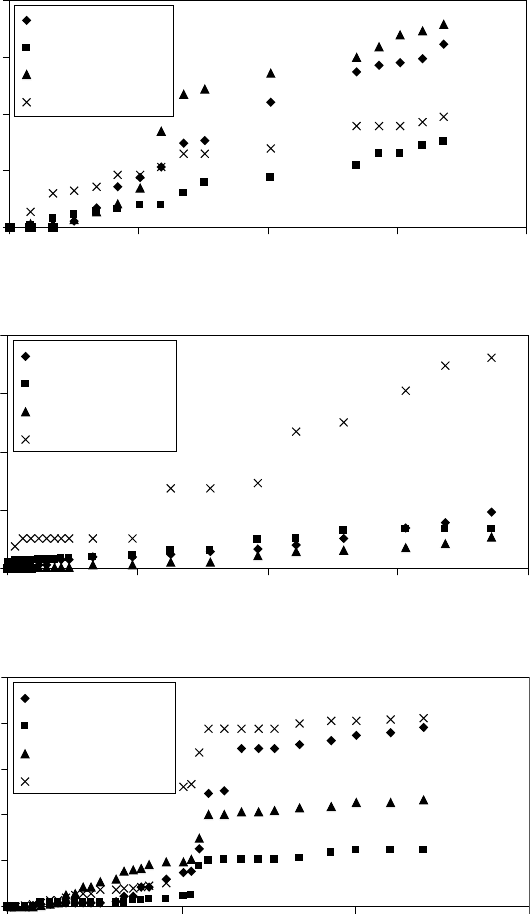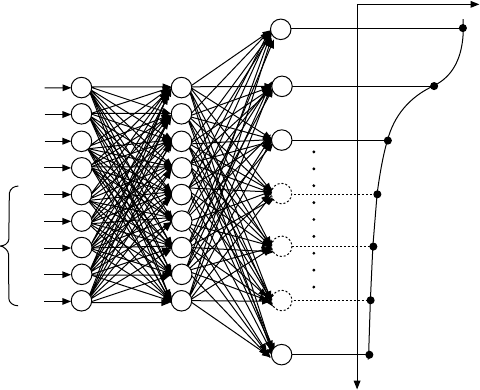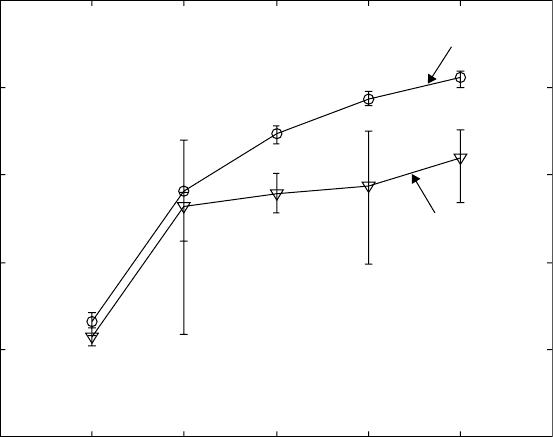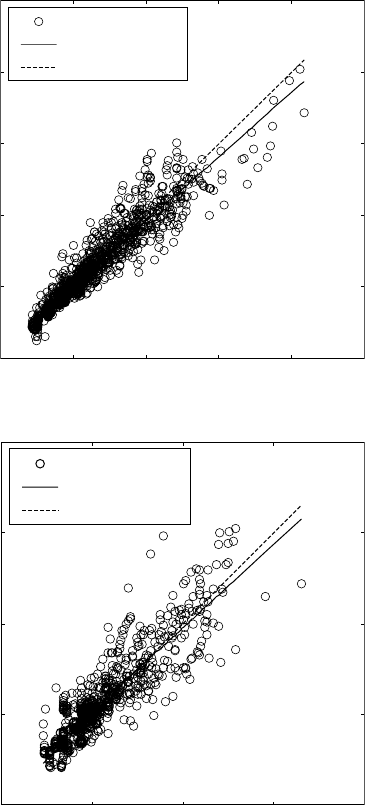Sha W., Malinov S. Titanium Alloys: Modelling of Microstructure, Properties and Applications
Подождите немного. Документ загружается.

Surface gas nitriding: mechanical properties, morphology 493
breaks the oxide film and the nitrided compound layers, leading to a significant
increase of weight loss.
1.8
M H
2
SO
4
Surface gas nitriding worsens the corrosion resistance of Ti-6Al-2Sn-4Zr-
2Mo in 1.8
M H
2
SO
4
at 20 and 80 °C solutions (Fig. 17.26). At a solution
temperature of 40 °C, the untreated and nitrided alloys are quite similar.
Surface gas nitriding worsens the corrosion resistance of Ti-8Al-1Mo-1V
in 1.8
M H
2
SO
4
at room temperature. After holding the same alloy at higher
medium temperatures of 40 and 80 °C, the alloy in the nitrided condition has
better corrosion resistance than that in the untreated condition. The weight
loss of the nitrided Ti-8Al-1Mo-1V increases with the time prolongation,
and with the increase of the temperature from 40 to 80 °C. There is no clear
tendency in the corrosion behaviour of Ti-8Al-1Mo-1V in 1.8
M H
2
SO
4
.
At 40 °C, the untreated Ti-6Al-2Sn-4Zr-2Mo has better corrosion resistance
in comparison with the untreated Ti-8Al-1Mo-1V.
At 80 °C, the nitrided Ti-8Al-1Mo-1V shows better performance than Ti-
6Al-2Sn-4Zr-2Mo and the opposite tendency can be seen for the untreated
alloys.
17.4.3 Influence of the corrosive medium
The corrosive medium is an important parameter determining the corrosion
behaviour of the materials. The corrosion behaviour of nitrided Ti-6Al-2Sn-
4Zr-2Mo and Ti-8Al-1Mo-1V in three different corrosive media at three
different temperatures is compared.
At room temperature, the Ti-6Al-2Sn-4Zr-2Mo alloy nitrided at 950 °C
for 5 hours has better corrosion resistance in sulfuric acid solution than in
hydrochloric acid solution. At 40 °C, the alloy shows a very good corrosion
resistance in 0.5
M NaCl. The corrosion resistance worsens in 1.8M H
2
SO
4
and the weight loss dramatically increases in 4.9M HCl. A similar tendency
exists at the higher solution temperature of 80 °C.
The Ti-8Al-1Mo-1V alloy nitrided at 950 °C for 5 hours is very resistant
to 0.5
M NaCl at 40 and 80 °C. The overall corrosion response is different
from the nitrided Ti-6Al-2Sn-4Zr-2Mo alloy.
17.4.4 Influence of the media temperature
In 0.5M NaCl solution, as mentioned earlier, the weight loss values of Ti-
6Al-2Sn-4Zr-2Mo after nitriding at 950 °C for 5 hours are very small. In
4.9
M HCl solution, the weight loss values are quite similar at 20 and 40 °C,
and they increase with the increase of the temperature to 80 °C. The same

Titanium alloys: modelling of microstructure494
17.26
Weight loss versus time of Ti-6Al-2Sn-4Zr-2Mo and Ti-8Al-1Mo-
1V, untreated and nitrided (950 °C for 5 hours), after holding them in
1.8
M H
2
SO
4
at (a) room temperature, (b) 40 and (c) 80 °C.
Weight loss (g/cm
2
)
0.004
0.003
0.002
0.001
0
0 1000 2000 3000 4000
Time (h)
(a)
Ti-6242, nitrided
Ti-6242, untreated
Ti-811, nitrided
Ti-811, untreated
Weight loss (g/cm
2
)
0.008
0.006
0.004
0.002
0
0 400 800 1200 1600
Time (h)
(b)
Ti-6242, nitrided
Ti-6242, untreated
Ti-811, nitrided
Ti-811, untreated
Weight loss (g/cm
2
)
0.01
0.008
0.006
0.004
0.002
0
0 500 1000 1500
Time (h)
(c)
Ti-6242, nitrided
Ti-6242, untreated
Ti-811, nitrided
Ti-811, untreated
Surface gas nitriding: mechanical properties, morphology 495
tendency exists in 1.8M H
2
SO
4
solution. The sudden jumps in the weight loss
values in both reducing acid solutions at 80 °C are probably due to the
breaking of the surface oxide and nitride layer.
As described by Galvanetto et al. (2002), the failure of the compound
layer is probably due to local dissolution of the layer, which leads to penetration
by the solution and then the fast corrosion of the inner titanium matrix,
eventually causing cracking and removal of the fragile compound layer.
There is a difference between the surface morphology of the untreated
and nitrided Ti-6Al-2Sn-4Zr-2Mo before and after the corrosion test, probably
due to an increase of surface roughness caused by the aggressive attack of
the corrosive medium.
Nitrided Ti-8Al-1Mo-1V has a similar tendency to the one for Ti-6Al-
2Sn-4Zr-2Mo. Ti-8Al-1Mo-1V has better corrosion resistance in all cases.
For untreated and nitrided Ti-6Al-2Sn-4Zr-2Mo and Ti-8Al-1Mo-1V alloys,
the corrosion rate increases with the increase of the temperature. For Ti-6Al-
2Sn-4Zr-2Mo, the corrosion rate in 0.5
M NaCl is up to 0.002 mm/yr and for
Ti-8Al-1Mo-1V is up to 0.006 mm/yr. In 4.9
M HCl, for Ti-6Al-2Sn-4Zr-
2Mo, the corrosion rate varies from 0.013 to 0.26 mm/yr, and for Ti-8Al-
1Mo-1V, it varies from 0.015 to 0.067 mm/yr. In 1.8
M H
2
SO
4
, for Ti-6Al-
2Sn-4Zr-2Mo, it varies from 0.007 to 0.13 mm/yr, and for Ti-8Al-1Mo-1V,
it varies from 0.017 to 0.13 mm/yr.
For most of the cases, the corrosion rate is below 0.13 mm/yr, which is the
maximum corrosion rate accepted by designers. The only exception is nitrided
Ti-6Al-2Sn-4Zr-2Mo in 4.9
M HCl at 80 °C, for which the corrosion rate is
0.26 mm/yr. The cases for which we have a corrosion rate below 0.04% can
be considered as fully passive conditions.
17.4.5 Summary of the corrosion resistance of
titanium alloys after gas nitriding
The correlation between the corrosion behaviour of titanium alloys and nitriding
processing parameters, the corrosive conditions and alloy composition is
important for many industrial applications.
The corrosion weight loss tests show that surface gas nitriding does not
change significantly the corrosion resistance properties of titanium alloys.
These properties depend on the corrosive environment and conditions. Titanium
alloys show excellent corrosion resistance in salt solutions. In aggressive
reducing acid solutions, gas nitriding either worsens or improves the corrosion
resistance, depending on the alloy composition, corrosive environment and
the corrosive solution temperature.
Ti-8Al-1Mo-1V has better corrosion resistance in comparison with Ti-
6Al-2Sn-4Zr-2Mo in most of the cases. The weight loss values increase in
most cases with increase of the solution temperatures from 20 to 80 °C and
Titanium alloys: modelling of microstructure496
time prolongation. The corrosion rate of Ti-6Al-2Sn-4Zr-2Mo and Ti-8Al-
1Mo-1V is below 0.13 mm/yr, with the only exception of nitrided Ti-6Al-
2Sn-4Zr-2Mo in 4.9
M HCl at 80 °C (0.26 mm/yr).
17.5 References
Fleszar A, Wierzchon T, Kim S K and Sobiecki J R (2000), ‘Properties of surface layers
produced on the Ti–6Al–3Mo–2Cr titanium alloy under glow discharge conditions’,
Surf Coat Technol, 131 (1–3), 62–65.
Galliano F, Galvanetto E, Mischler S and Landolt D (2001), ‘Tribocorrosion behavior of
plasma nitrided Ti–6Al–4V alloy in neutral NaCl solution’, Surf Coat Technol, 145
(1–3), 121–31.
Galvanetto E, Galliano F P, Fossati A and Borgioli F (2002), ‘Corrosion resistance properties
of plasma nitrided Ti–6Al–4V alloy in hydrochloric acid solutions’, Corros Sci, 44
(7), 1593–606.
Gokul Lakshmi S, Arivuoli D and Ganguli B (2002), ‘Surface modification and
characterisation of Ti–Al–V alloys’, Mater Chem Phys, 76 (2), 187–90.
Kessler O, Surm H, Hoffmann F and Mayr P (2002), ‘Enhancing surface hardness of
titanium alloy Ti-6Al-4V by combined nitriding and CVD coating’, Surf Eng, 18 (4),
299–304.
Malinova T, Malinov S and Pantev N (2001), ‘Simulation of microhardness profiles for
nitrocarburized surface layers by artificial neural network’, Surf Coat Technol, 135
(2–3), 258–67.
Meletis E I (2002), ‘Intensified plasma-assisted processing: Science and engineering’,
Surf Coat Technol, 149 (2–3), 95–113.
Shashkov D P (2001), ‘Effect of nitriding on the mechanical properties and wear-resistance
of titanium alloys’, Metallovedenie i Termicheskaya Obrabotka Metallov, 6, 20–25.
Takahashi A and Kimura Y (2001), ‘Evaluation of wear corrosion characteristics of Ti-
6Al-4V in quasi-human body environment and improvement of wear corrosion
characteristics by gas nitriding’, in Dominguez J (ed), Computational Methods in
Contact Mechanics V, Southampton: WIT Press, 117–26.

497
18
Nitriding: modelling of hardness
profiles and the kinetics
Abstract: The first half of the chapter shows the reader how results from
microhardness testing can be used to develop artificial neural network
models for the simulation and prediction of microhardness profiles after
nitriding in relation to the type of nitriding, temperature, length of time of
nitriding, gas mixtures and alloy composition. The second half switches to
physical modelling of the evolution of surface layers during gas nitriding.
These models are based on analytical and numerical solutions of the
diffusion equation and calculate the nitrogen distribution, the thickness of
the nitrided layers and the incubation time for the formation of layers on the
surface.
Key words: neural network, microhardness, diffusion, kinetics, numerical
simulations.
18.1 Artificial neural network modelling of
microhardness profiles
Gas and plasma nitriding are among the most widely used thermo-chemical
treatments for improving the surface properties of titanium alloys. There
have been many studies on these types of treatments, especially of titanium
alloys (Galliano et al., 2001; Shashkov, 2001). They are diffusion methods
that can easily increase the hardness of these alloys. Understanding the
correlation between the processing parameters of nitriding and the hardness
of the materials is important, because this would allow an optimisation of the
processing parameters and alloy selection in order to achieve properties
desired for various applications. Artificial neural network (ANN, Chapters
13–15) (Keong et al., 2004; Li and Xiong, 2002; Li et al., 2002a,b; Öhl et
al., 2003) models can be develped and used to help achieve this purpose.
This section will describe artificial neural network modelling for simulation
and prediction of microhardness profiles of titanium and titanium alloys
after gas and plasma nitriding. The basic principles of this modelling technique
are described in Chapter 13. Apart from modelling, ANNs can be applied for
classification, transformation, association and process control (Chapters 13
and 15) (Malinova et al., 2001).
There are two different types of neural networks – hierarchical networks
and auto associators. The choice of the type of neural network depends on
the nature of the problem to be solved. In this section, feed-forward hierarchical
networks are used. The model is shown schematically in Fig. 18.1.

Titanium alloys: modelling of microstructure498
18.1.1 Model description
Input parameters
The training of an ANN requires a large number of input/output pairs. This
leads to more precise work but also an increase of the training time. The
most important parameters of gas and plasma nitriding used to obtain desirable
surface properties are temperature of the process, time for saturation and gas
atmosphere.
As input parameters for the model, type of nitriding, temperature and time
of nitriding, gas mixtures and the chemistry of the titanium alloys presented
by the following most commonly used alloying elements and impurities: Al,
V, C, Fe, N, O, Sn, H, Ni, Mo, Si, Zr, Cr, B are used. For the design of the
ANN, input/output pairs from the published literature, including data by
Galliano et al. (2001) and Shashkov (2001), as well as the experimental data
in Chapter 17 on gas nitriding, are collected, pre-processed and used.
For the input parameter ‘type of nitriding’, the following notations are
adapted:
• plasma nitriding ‘1’
• gas nitriding ‘2’.
For the input parameter ‘gas mixture’, the following notations are adapted:
i
= 20,
x
= 400 µm
x
(µm)
Microhardness profile of
titanium alloys
HK
Output layer
i
= 1,
x
= 1 µm
i
= 2,
x
= 4 µm
i
= 3,
x
= 9 µm
Hidden
layer
Input
layer
Al
V
Mo
Fe
…
Titanium
alloys
composition
Type of nitriding
Temperatue
Time
Gas mixture
18.1
A schematic model of ANN for simulation and prediction of
microhardness profiles of titanium alloys after gas and plasma
nitriding.
Nitriding: modelling of hardness profiles and the kinetics 499
• pure N
2
‘1’
• 80%N
2
-20%H
2
‘2’
• 77%N
2
-22%H
2
-1%C ‘3’
• 70%N
2
-24%H
2
-6%C ‘4’
• NH
3
‘5’
• 95%N
2
-5%H
2
‘6’
• 80%N
2
-20%Ar ‘7’.
The output parameter, which in this case is a graph, also has to be converted
to a numerical format. Following this aim, all graphics are scanned, put in
electronic format and rescaled to the same scale. All the values are transformed
to Knoop hardness using the conversion tables. After these procedures, each
microhardness profile is described by a set of numbers giving the hardness
values at distance x from the surface (where x = i
2
and i =1, 2, 3, 4, …, 20).
In this way, the output, given schematically in Fig. 18.1 as a graph, is actually
presented by a set of 20 output neurons. All the data that are not consistent
are excluded from the dataset, such as methods of nitriding with processing
parameters not covered above or experimental cases not fitting well to the
general database.
Training
Descriptions of the ANN transfer functions, Levenberg–Marquardt training
method and Bayesian regularisation are given in Chapter 13. In order to
determine the optimal architecture, several steps are required. The alloying
elements that are present in a small number of cases are ignored, as well as
the impurities. Only seven alloying elements remain as input parameters and
they are Al, V, Fe, Sn, Mo, Zr and Cr. Training with the dataset of 112 data
was performed. The influence of the number of neurons in the hidden layer
on the NN response, shown by the correlation coefficient (R) for the training
and the whole datasets, is given in Fig. 18.2. For each case, the values for the
R coefficient are the average from five separate training runs under the same
conditions and using a different random distribution of the dataset. When the
number of neurons in the hidden layer is increased from one to three, the R
coefficient for both training and whole datasets increases. A further increase
of the neurons to five makes a further slight improvement of the NN, although
the correlation coefficients remain stable and do not change dramatically.
The best NN architecture is when there are five neurons in the hidden
layer. For this case, 50 runs with different database distributions were performed,
and the best case for the NN architecture and data distribution was found.
The performance for this case is demonstrated in Fig. 18.3. The figures show
a linear regression analysis between the network outputs (predictions) and
the corresponding targets (experimental data) for the different datasets. The
correlation coefficient R values for all cases of training, test and whole

Titanium alloys: modelling of microstructure500
datasets are above 0.88. This means that a good performance of the neural
network is achieved and the network can be used for further simulations and
predictions. The optimum performance of this model has eleven neurons in
the input layer, five neurons in the hidden layer and twenty neurons in the
output layer.
The data for plasma nitriding and the data for nitriding in nitrogen
atmospheres different from pure N
2
are quite limited. Will including these
data as inputs in the model make it possible for it to predict efficiently
microhardness profiles for new situations for plasma nitriding and nitriding
using different gas mixtures? A second model, excluding all the data for
plasma nitriding and all the data using gas mixtures different from pure N
2
,
is created in order to see the influence of these two parameters on the
performance of the NNs. This leads to a decrease of the input parameters
from 11 to 9. The whole dataset is for gas nitriding performed in a pure
nitrogen atmosphere. The training is performed with 9 inputs, 20 outputs and
84 data pairs, with 56 in the training dataset and 28 data for test. The number
of neurons in the hidden layer varies from 1 to 5. Then, the best correlation
coefficients for Bayesian regularisation are selected and these are for 5 neurons.
50 runs were again performed for this case with different database distributions,
and the best case for the new NN architecture and data distribution is given
in Fig. 18.4. The correlation coefficient R values for all cases of training, test
Train
All
0123456
Neurons in hidden layer
Correlation coefficients
1
0.95
0.9
0.85
0.8
0.75
18.2
Influence of the number of neurons in the hidden layer on the
neural network performance.

Nitriding: modelling of hardness profiles and the kinetics 501
and whole datasets are above 0.91 which means a good performance of the
neural network, slightly better compared with the first model. The optimum
performance of this second model has nine neurons in the input layer, five
neurons in the hidden layer and twenty neurons in the output layer.
Data points
Best linear fit
A = T
R = 0.95
0 400 800 1200 1600 2000
(T) Experimental microhardness (HK)
(a)
(A) Neural network simulations (HK)
2000
1600
1200
800
400
0
Data points
Best linear fit
A = T
0 400 800 1200 1600
(T) Experimental microhardness (HK)
(b)
(A) Neural network simulations (HK)
1600
1200
800
400
0
R = 0.887
18.3
Microhardness values predicted from the first neural network
model versus experimental microhardness for (a) the training, (b)
test and (c) the whole dataset.

Titanium alloys: modelling of microstructure502
At the end of the NN training, there are two trained models that can be
used for simulation of microhardness profiles of nitrided titanium alloys.
The first model can predict microhardness profiles after gas and plasma
nitriding using different gas mixture. The second model can predict
microhardness profiles after gas nitriding only in a pure nitrogen atmosphere.
These models are compared in the following sections.
Performance and test
The neural networks performance is checked after the training, using the test
dataset and the whole set of the two models. The linear regression presented
in Figs. 18.3b,c and 18.4b,c is a kind of neural network test. Furthermore,
the experimental microhardness profiles and those predicted from the trained
neural networks are compared in Fig. 18.5, where there is no significant
difference between the predictions from the two models. A good agreement
between the experimental microhardness profiles and prediction from the
NNs is shown.
18.1.2 Use of the neural networks for simulations
and predictions
NN modelling gives the correlations between the model inputs (which in this
case are the processing parameters and the alloy compositions) and the model
Data points
Best linear fit
A = T
R = 0.931
0 400 800 1200 1600 2000
(T) Experimental microhardness (HK)
(c)
(A) Neural network simulations (HK)
2000
1600
1200
800
400
0
18.3
Continued
